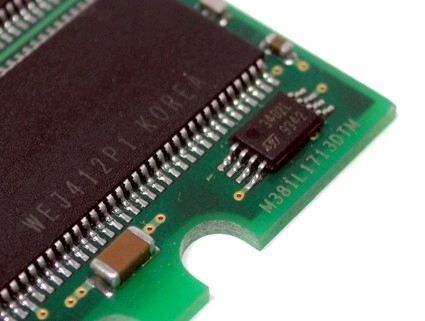Navigating the Memory Upgrade Jungle
Memory Speeds Explained
RAM is normally rated at its highest tested stable speed, first by the chip manufacturer in cycle time (measured in nanoseconds, abbreviated ns), then by the module producer in frequency (megahertz, or MHz). Because of the inverse relationship between cycle time and frequency, knowing the rated frequency for a single chip is as easy as inverting cycle time and moving the decimal place. For example, 200 MHz SDRAM would be equivalent to 5 ns, because 5 ns equals 0.005 microseconds, and 1 divided by 0.005 equals 200.
By design, DRAM maintains its data only as long as a charge is applied to the cells, so there is no maximum cycle time. For example, 133 MHz SDRAM could operate at 133 MHz, 100 MHz, 66 MHz, or even at speeds of less than 1 MHz, depending on how quickly the system accesses it. This allows a wide range of compatibility for higher speed modules in older systems; it is common practice for manufacturers to re-label faster RAM at slower speeds whenever the slower RAM ceases production. (This explains the popularity of "PC100" modules that use 7 ns chips.)
Double Data Rate (DDR) technology allows data to be transmitted twice per clock cycle, so DDR SDRAM with a 200 MHz clock rate actually has a 400 MHz data rate, and is referred to as DDR400. The naming convention for finished modules has become its bandwidth, with each module providing 64 data connections for 8 Bytes of data per transfer. A 400 MHz data rate multiplied by 8 Bytes per transfer provides 3,200 MB/s bandwidth, hence the name PC3200.
Previous memory types were rated by their speed or data rate alone, with PC133 SDRAM specified to support at least 133 MHz operation at 100% stability, and PC800 RDRAM specified to operate at 800 MHz data rate. A well known but little publicized fact is that RDRAM also used DDR technology, so that PC800 RDRAM ran at a 400 MHz clock rate.
RDRAM presented a unique circumstance for the industry, because its high clock speed was undermined by its narrow bus width, initially providing only 16 bits and later 32 bits. In fact, 16 bit PC800 in dual-channel mode (32 bits via parallel pathways) had the same bandwidth as "slower" DDR400 SDRAM in single channel mode (64 bits). For this reason, DRAM manufacturers chose to use higher bandwidth numbers, rather than data rate, to specify their DDR SDRAM modules.
The Serial Presence Detect Chip Stores Vital Configuration Values
A small chip on each module, called a Serial Presence Detect (SPD) chip, stores information about the rated speed and appropriate timing settings for the module; this data is sometimes referred to collectively as a set of SPD values. The chip is read by the motherboard BIOS at boot time to assure the proper automatic configuration settings are used. Faster RAM is always compatible with slower speeds, but some motherboard BIOS limitations may not allow this RAM to be properly configured due to unrecognized SPD values.
Get Tom's Hardware's best news and in-depth reviews, straight to your inbox.

